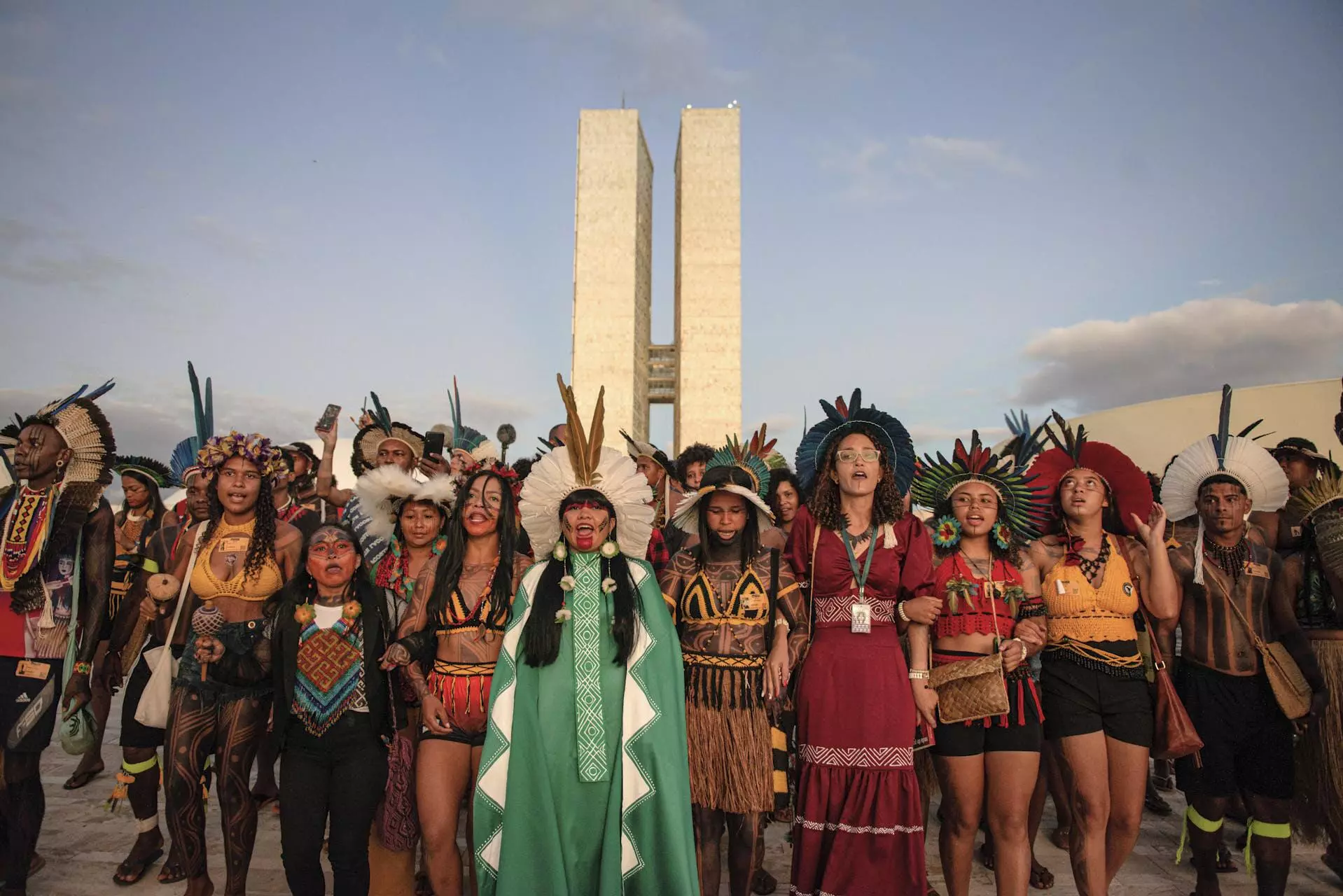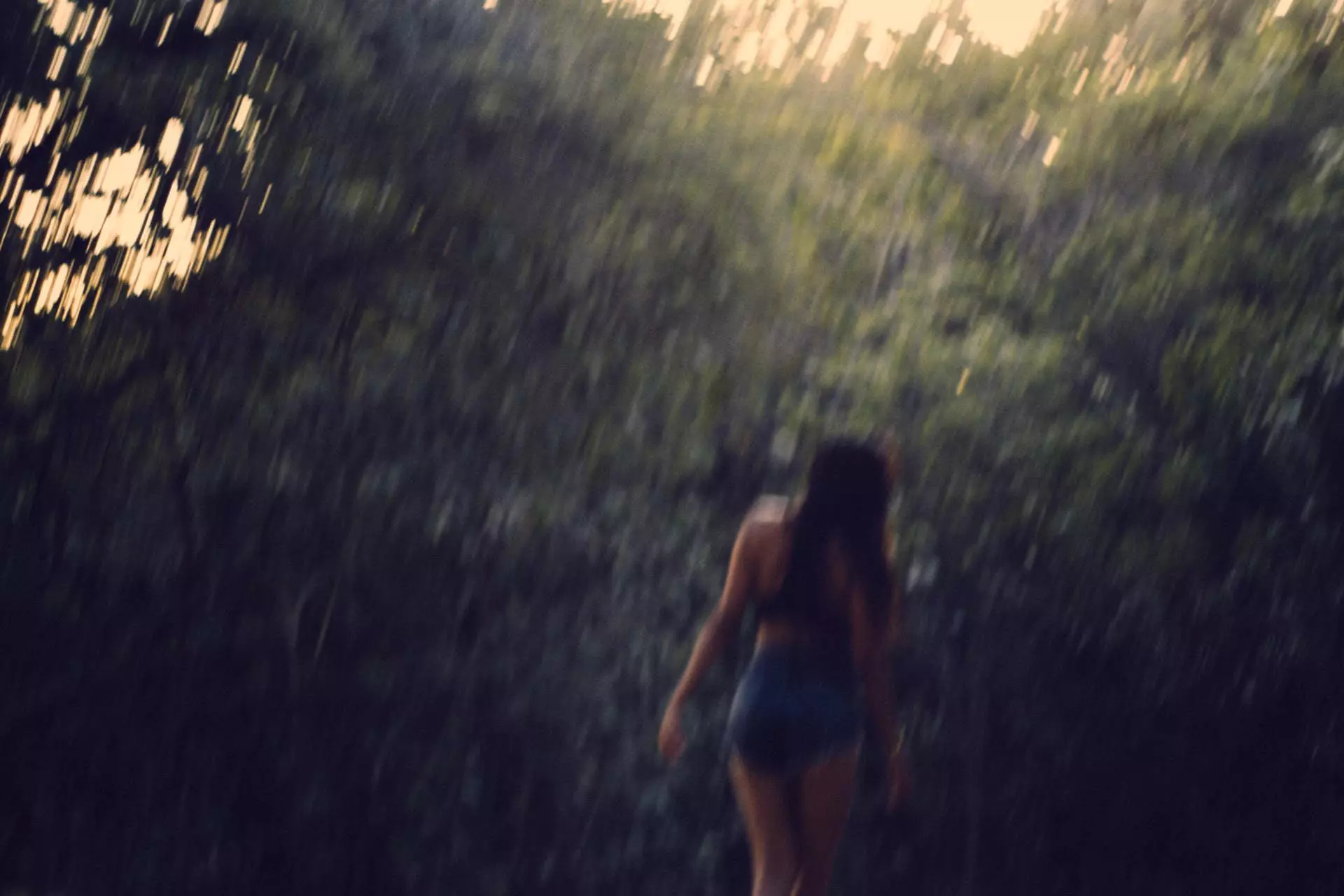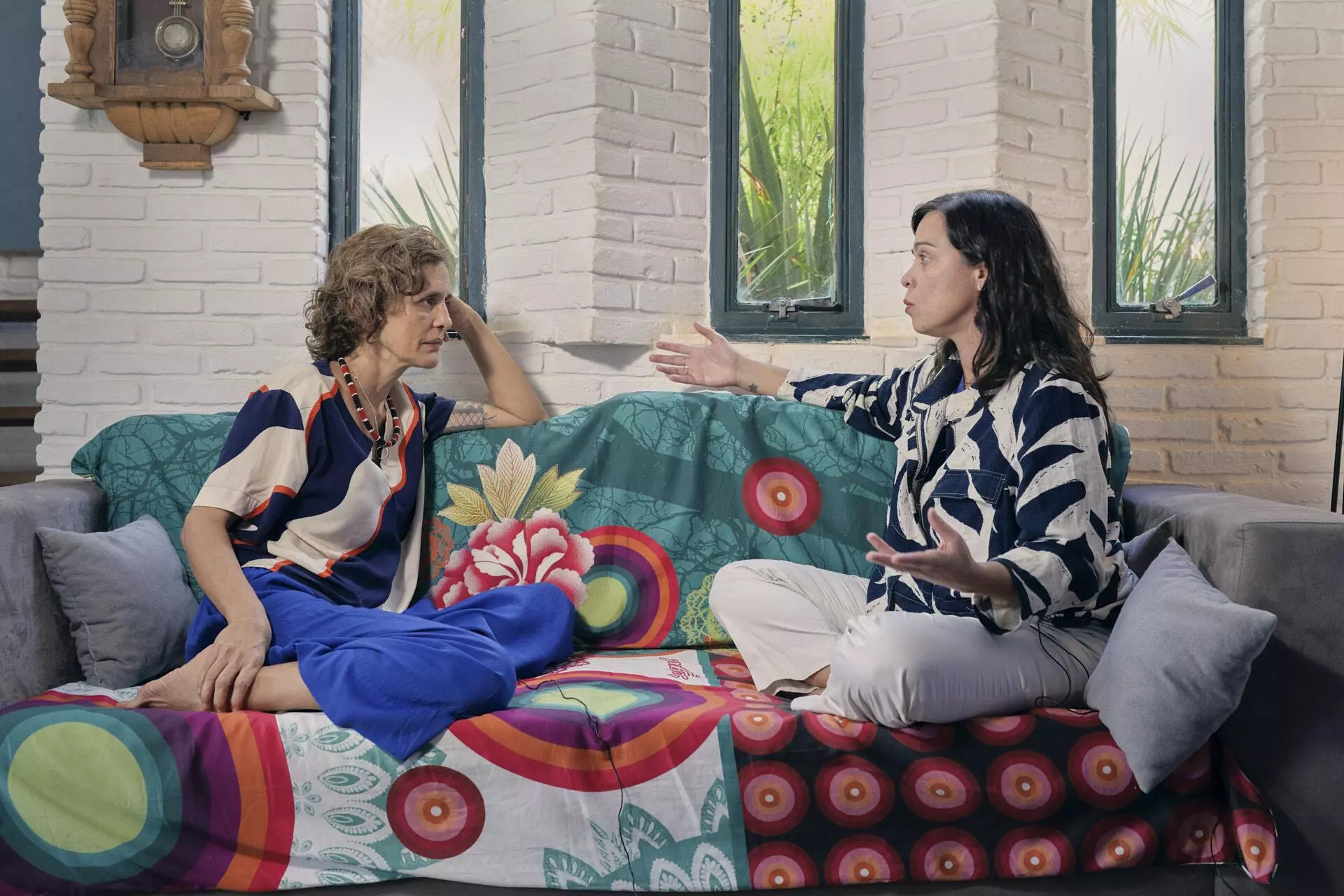Larissa Pankararu, of the Pankararu people in Pernambuco, always has her maraca and copiô [pipe] close to hand. Her grandfather gave her the Indigenous instruments when she passed her university entrance exam and was accepted into the environmental engineering program at the Universidade de Brasilia. According to him, Larissa would need this protection to face her many future missions in Brazil’s federal capital. The Pankararu elder was prescient. Last year, Larissa ran for federal deputy on the Socialism and Liberty Party (PSOL) ticket, joining with several other Indigenous women to compete for a single seat in Congress, a political innovation in Brazil called a collective candidacy. This past April, Indigenous peoples minister Sonia Guajajara invited Larissa to serve as coordinator of Indigenous LGBTQIAPN+ policy within the ministry’s Department for the Organization and Promotion of Indigenous Rights. Twenty-seven years old and openly gay, Larissa holds a seat at the center of power, serving alongside some of the most prominent Indigenous leaders in Brazil.
“I’m always reaching for [the maraca] to do a blessing and focus on strength,” Larissa said. She removes the instrument from a small pouch slung around her neck and raises it in the air, demonstrating a ritual request for protection. “And this is the copiô, the pipe we use in our rituals to connect with our ancestors, with our spirituality.”
As a teenager, Larissa met now minister Sonia Guajajara when the Indigenous leader visited the Pankararu territory. Later, in 2018, young Larissa was with some friends at a bar in Aracaju, where she was attending college at the time, and someone gave her a campaign flyer for Guilherme Boulos, who was running for president, with Sonia as his running mate. “The representativity of it shocked me. I thought to myself, I want to be this woman in the future; this woman represents me.”
According to Larissa, the challenge in the ministry will be to map Indigenous LGBTQIAPN+ youth and formulate public policies, especially in health and education. “When we talk about diversity, it’s not just the diversity of biomes,” she said. “It’s the diversity of peoples, of languages, and also the diversity of bodies. It’s the diversity of love, it’s the diversity of cocares [headdresses] and colors. It’s the diversity of body, soul, and territory.”
Larissa and her partner, Amanda—a member of the Pankará people who is also from Pernambuco—are open about their relationship while also serving as examples for Indigenous youth who are fighting against discrimination inside and outside Indigenous villages. In a conversation that took place in two stages, the first in April at the annual Indigenous Free Land Camp in Brasilia and the second in May and June through an exchange of messages, Larissa talked about how important it is to lend visibility to Indigenous LGBTQIAPN+ youth and about the prejudice she faces as a Northeasterner, a woman, an Indigenous, and a lesbian—a “multiple whammy,” in her words. “I want people to at least see us. The gender question doesn’t make me any less Indigenous.”
SUMAÚMA: In April, you became head of the Coordination Sector for Indigenous LGBTQIAPN+ Policy, which is part of the Department for the Organization and Promotion of Indigenous Rights, within the Ministry of Indigenous Peoples. How did Sonia Guajajara’s invitation come about?
LARISSA PANKARARU: This is a totally new sector. I was on vacation in Pernambuco, with my people, and Sonia called me to propose this challenge. It was something really special, because I saw she believed in me to head up the coordination sector. I’ve always had this connection with my spirituality when I’m deciding if it’s the moment, if it’s time, if I’m ready; or I’ll ask [my ancestral spirits] if they can prepare me. I reflected on those things. I felt it was the right moment. Because this moment is crucial for Indigenous peoples. We built this through the Bancada do Cocar [Headdress Caucus], through the project to launch more Indigenous candidates, to give Indigenous peoples greater visibility. It’s not just about appearing in the media—we want Indigenous peoples to have an actual presence [in spheres of power].

Since taking office at the ministry in April, Larissa has been researching ways to map Brazil’s Indigenous LGBTQIAPN+ youth. Photo: Pablo Albarenga/SUMAÚMA
Were you expecting this invitation?
The invitation to head up the sector took me by surprise. I told my cousins, my sister, and my aunt, Carmem Pankararu, who is a really inspiring woman for me and who is also a leader, a political organizer of the grassroots movement, and has always been on the forefront in building specific policies for Indigenous peoples, especially in health. Shortly before then, I had spoken with her about my sexuality, and she was super accepting.
Then I prepared myself to talk to my parents about it, because they needed to understand what was happening, about the call [from the minister]. My mother was a little more reserved, didn’t say much. My father questioned me, wondering how I was going to deal with it. He was quite worried too, because this is a really sensitive issue and doesn’t get talked about much. Amanda, my partner, was very worried about the potential exposure, but from the start, she was also super happy. And Sonia gave me confidence, which I passed on to them.
We reached the conclusion, together, that I should accept the invitation and take the post. We would all move forward together. And of course I consulted my spiritual guides, my God, always asking them to guide me to the answer, to show me a path. I’ve always felt I have a mission, as if it were a preparation for something greater yet to come, part of my mission here on Earth, as a human.
You had the opportunity to get to know Sonia Guajajara, Célia Xakriabá, and other national Indigenous leaders in 2022, when you were a candidate with the Bancada do Cocar [Headdress Caucus]. Are there any other political projects in the works? Do you plan to run for office in 2024 or 2026?
It all happened so fast; it was so intense, but all very amazing. It was like watching a dream, truly. I began participating in the National Alliance of Indigenous Warrior Women of the Ancestors [Anmiga]. I felt very represented by this organization of warrior women of the ancestors, of the biomes. My aunt, Cris Pankararu, was one of the cofounders of Anmiga. The idea was to strengthen Indigenous women in politics and talk more about the presence and importance of Indigenous women in these spaces of power. This awakens the force of our ancestry, of nature—of this whole context that dwells within us, Indigenous women.
I intend to continue in politics, but not in 2024 or even in 2026. I want to prepare myself better. I don’t have plans to run again in 2024 or 2026, but I realize it might happen, right? Just like it happened in 2022. I intend to go back to my territory and follow a political career there, with my folks, my people. I’ve thought about possibly running for mayor of my municipality, Jatobá, Pernambuco, in 2028. But I also believe I might be asked again in 2026.

During the 2023 Free Land Camp, Brazil’s largest Indigenous gathering, held annually, Larissa took active part in the debate about Indigenous LGBTQIAPN+ youth. Photo: Matheus Alves/SUMAÚMA
The issue of LGBTQIAPN+ youth has been added to the Indigenous movement’s agenda, as apparent during discussions at the 2023 Free Land Camp. How does this resonate among Indigenous peoples right now? Is there prejudice?
This is a very delicate matter because there is some resistance to talking about this on the part of our leaders, our caciques [leaders], and the community itself. I don’t know if they think there might be some kind of interference [with the Indigenous movement’s struggle]. I don’t know how they feel it might be bad for their community, for Indigenous LGBTQIAPN+ to be mobilized. So our dynamic is one of ongoing dialogue, which has to be with respect, because we’re never going to go to our communities and just order our leaders to accept and respect us. But we want them to understand that we exist, resist, and are part of the territory, that we’re part of the people, of spirituality, and that our sexual identity, our gender, our sexuality, isn’t going to interfere with anything. This doesn’t make us any less Indigenous than they are.
Is this resistance more prevalent among the older Indigenous, in the villages? Do Indigenous youth view this matter differently?
It’s a bit of both. We believe this all has to do with the invasion [of Indigenous territories], with colonization. Our people aren’t violent, disunited, or inhuman. But colonization brought these results, these marks. The Catholic and Evangelical churches have long wielded a great deal of influence in our Indigenous communities. [The prejudice] stems in part from this root.
How have Indigenous LGBTQIAPN+ youth begun organizing to call attention to this issue, and which peoples handle this debate better?
This is delicate and complex. We Indigenous peoples number 305, each with our own customs, our own viewpoint. It depends on each people. My people has one kind of behavior and viewpoint; my friend’s has another [Larissa talked to SUMAÚMA alongside her friend Fêtxawewe, of the Guarani and Funiô people and also LGBTQIAPN+]. Speaking for my people, I’d say I can have a little more dialogue with them, and I can make them understand that the gender question doesn’t make me any less Indigenous. But in other peoples, our relatives [as the Indigenous refer to any other Indigenous] aren’t accepted this way; they are discriminated against, invisibilized, ostracized; very often, they are even barred from being present. So it depends on each people, on the context of each community.
You really underscore your spiritual connection and have said you believe the gender and sexuality bias among older Indigenous, in the villages, has a lot to do with processes of religious colonization. But is there anything in Indigenous traditions, in the culture and spirituality of Indigenous peoples, that may somehow explain why this subject causes so much discomfort?
No, there isn’t. This has nothing to do with Indigenous spirituality. It has to do with human beings, flesh and blood. It’s not from the beyond. I have a lot of this contact, and I feel the force of spirituality within me. I feel like they prepare me every day for this mission, which is living as an Indigenous person, as a woman, as LGBT, as a Northeasterner who is in this state called the Federal District, in this universe of Brasilia, which is completely unequal, elitist. A multiple whammy. But spirituality prepares me, renews me, strengthens me, and I am certain it shows me nothing but good, nothing but love, nothing but warmth, nothing but good things.
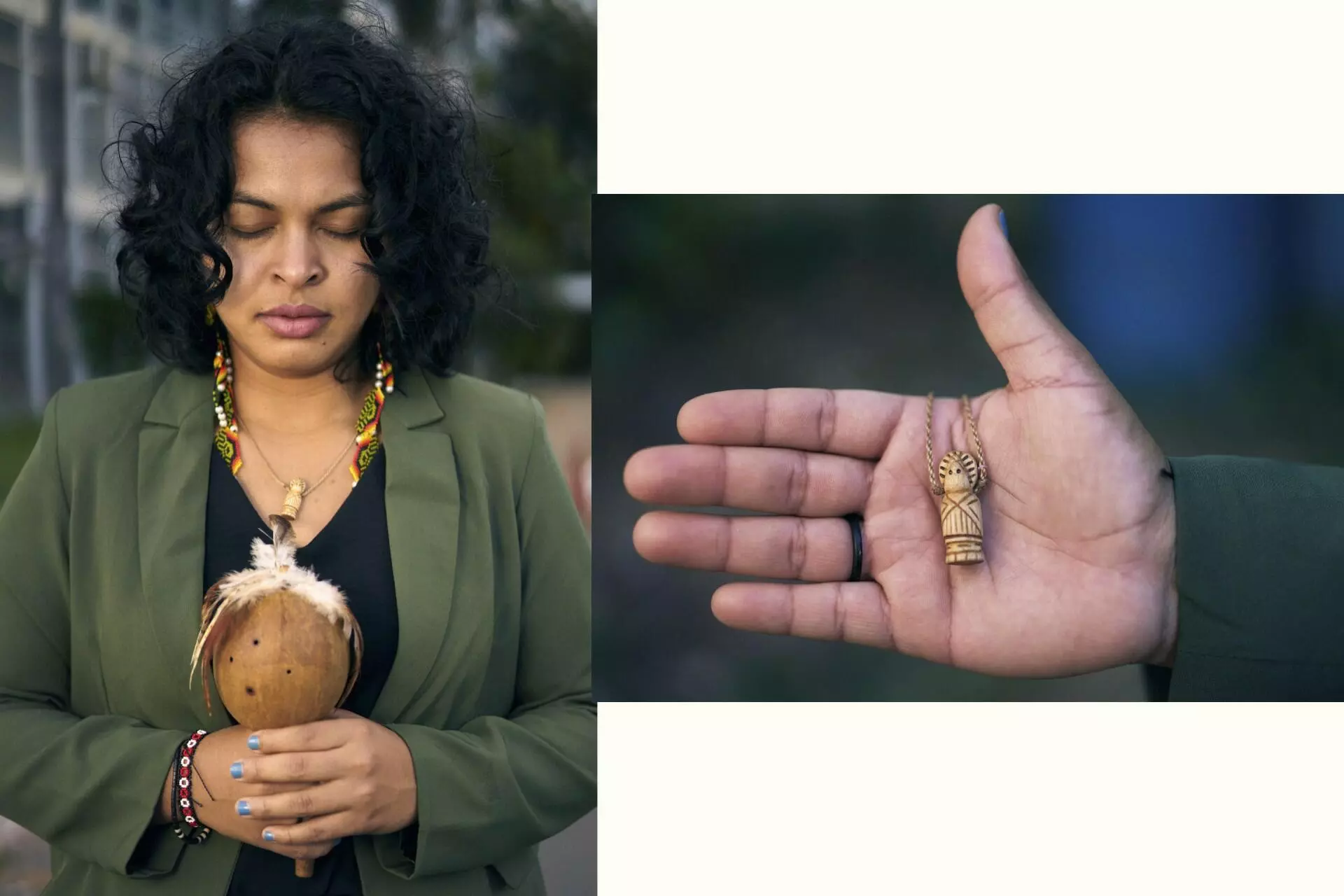
Focus on spirituality: the young Indigenous leader shows the amulet that protects her, along with her maraca. Photos: Pablo Albarenga/SUMAÚMA
Was there some recent event that spurred Indigenous youth to take up this debate in such an organized way?
We’ve reached the point where we truly understand it isn’t a problem. And that they [Indigenous peoples broadly] need us, as a collective, as a community. Together, as an Indigenous community, as an LGBT community, we are stronger. We are stronger when we are united. And at schools, at universities, in politics. We understand that the moment has come for us to talk about this issue because of all we’ve worked toward and continue to build. This is the moment for us to speak, to demonstrate that we exist and resist. The Ministry of Indigenous Peoples formed this sector so it could address this issue because it too feels that the moment has come.
Are there any LGBTQIAPN+ associations, collectives, or groups within the Indigenous movement today?
Yes, there are collectives in the Indigenous movement, like Tybyra for example, the first collective founded and created by Indigenous LGBT people who’ve been at the forefront of this struggle for many years. We have Tybyra as a point of reference. The idea now is for us to build up strength.
A ministerial sector like this one will present challenges. How do you plan to start organizing these debates around Indigenous LGBTQIAPN+ issues?
There are so many challenges. This is a new sector, in a new ministry. But our main goal is to have a dialogue, to listen. To listen to our relatives’ demands as well as those of Indigenous LGBT people inside and outside our territories. Like I said, we are 305 peoples, each with our own needs and demands. We need to listen to those demands. We’ve also been seeking allies. Right now it’s very important for us to figure out who is truly with us in this struggle and who’s just here because they want to occupy this space and take advantage. This is the time to show [our presence]. I want to reach out to other ministries, municipal and state boards. Those in Indigenous health [in the government] have also volunteered to discuss matters of interest to the LGBT community. It’s time.
So the first step is to map Indigenous LGBTIAPN+ youth across the country and then incorporate this discussion into the Indigenous movement while also seeking an exchange between various government ministries to ensure the public policies are implemented?
That’s right. You’ve just summed up everything I was trying to convey. . . We want to map and listen to the youth. And then, together with the Indigenous LGBT youth, seek out partnerships with other public agencies, other ministries, so we can back each other, join forces, and make some public policies happen.
Congress deforested the Ministry of Indigenous Peoples, removing its responsibility for overseeing the demarcation process. You took office with a lot of ideas. Given these political defeats, have you been able to implement any concrete measures in your sector? Can you tell us about any actions that are currently underway?
Even while we celebrate that the Ministry of Indigenous Peoples exists, because it is such an important achievement, and a historical one too, not only for Indigenous peoples but for all the people of Brazil, on the other hand it saddens us that Brazilian society still can’t see how important it is that we are speaking on our own behalf, that we are at the center of these discussions and debates. It’s been an intense, daily battle for us to stand tall, to not bow our heads to them, to Bolsonaro’s anti-democratic supporters. But we rose to the challenge, we know what it means to resist in order to exist. We’ve been doing it and will continue to do so.
Unfortunately, I can’t say I have any concrete measures in place for LGBT youth. What I can say is that I’ve been doing a lot of research and a lot of pushing, as far as possible. I’ve only been in this sector for two months, but the plan is to spend every day pushing for concrete measures to be implemented. The complaints and cases I’ve heard about from LGBT Indigenous youth have left me feeling increasingly concerned while also helping me understand how important this sector is. I’ve been trying to find ways to combat violence against the diverse bodies of the Indigenous peoples, to combat sexism, prejudice, homophobia. So that at the very least people will see us. To this day I find it incredibly difficult to hear people ask: Wow, do Indigenous LGBT people exist? Huh, really. . .
I want the country to realize that a policy sector exists for the Indigenous LGBT community within the Ministry for Indigenous Peoples, because we are diverse peoples. When we talk about diversity, it’s not just the diversity of biomes. It’s the diversity of peoples, of languages, and also the diversity of bodies. It’s the diversity of love, it’s the diversity of cocares [headdresses] and colors. It’s the diversity of body, soul, and territory.
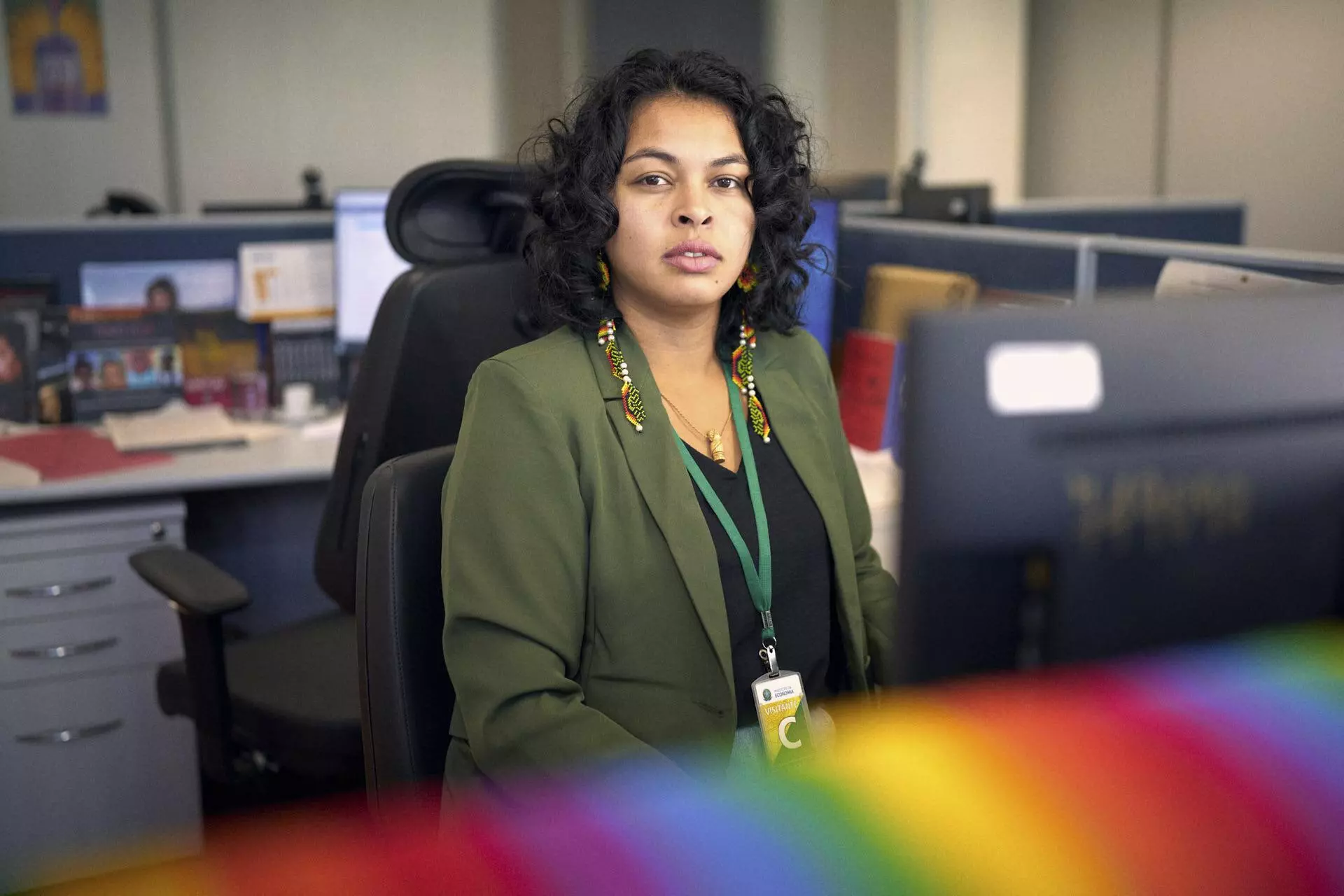
In her office at the Indigenous peoples ministry, in Brasilia, Larissa exercises her new role alongside Minister Sonia Guajajara. Photo: Pablo Albarenga/SUMAÚMA
Before accepting this position in the ministry, what were you doing?
I’m an environmental engineering student in Brasilia, at the Universidade de Brasilia, and an environmental activist for territorial and historical reasons. I was the representative of the Indigenous youth movement in that same area – the environment. I’m still enrolled in environmental engineering today [even after taking office]. I just love talking and learning about the environment. I’m totally passionate about it. In my territory, we’ve set aside spaces for the recovery of our caatinga forests, our springs. I want to study this. I have to. Without the environment, there is no life for us. The land, the environment – that’s life. So, before anything else, we have to talk about the climate crisis, about the loss of our rivers, our springs, our nature. I really believe that.
Why did you choose this subject for your undergraduate studies? And what obstacles did you, as an Indigenous woman, encounter to get into UnB?
My father is an environmental manager and an environmental technician. My mother, even though she never trained in that field, was always there, learning alongside my father. So that partly influenced my decision. But as the course progressed, I began enjoying environmental studies as a field and also understanding how important, how necessary it is for us to be educated in this area. Especially as an Indigenous person. Getting this education would be extremely important for me, as an Indigenous woman, and for my people, for Indigenous people. But it’s a really difficult course. I became deeply involved in environmental discussions, and the more involved I became, the more passionate I felt about it.
I was already enrolled in environmental engineering in Aracaju, Sergipe. Then, in 2019, I sat the Indigenous college admissions exam in the municipality of Tacaratu [Pernambuco] and was accepted to the same course at the Universidade de Brasilia. Except it’s a million times harder, not to mention all the other challenges. The distance, the financial troubles, the absence of public policies specific to Indigenous students, the big-city prejudices, the sexism, the violence – all of these were a cumulation of obstacles. My dreams of graduating seemed to be getting harder and harder. But, at the same time, UNB teaches, it educates and transforms. And at the same time as I faced these difficulties, I was thankfully also experiencing both personal and professional growth – and I was maturing as well.
You mentioned your partner, Amanda. Your story is well-known in the Indigenous movement. Have you had to deal with a lot of prejudice then and now, or was it easy to be open about your relationship?
It varies a lot. We’re part of a very large, strong Indigenous youth group. And we’re there for each other. And within that large Indigenous youth group, there is an Indigenous LGBT youth group, and we are also there for each other. Most of these people have to deal with prejudice within their families, in the spaces they inhabit, in universities. We have to build strength as a community, as a collective. From the very start, when Amanda and I got together and decided to be open about our relationship, our friends were incredibly supportive of us. She also went to my territory and learned a little about my culture and tradition. My family was super welcoming. But, at that time, we hadn’t made our relationship official yet. Maybe if we had, they’d have reacted differently.
But you did come out about your relationship. Is your family still supportive and respectful of your choices? Are you planning to make your union official in a ceremony of some kind?
Yes. They [my family] still don’t want to discuss it. But I’ve been chipping away, trying to break down barriers. And taking this position in the ministry has given me a new perspective. Amanda is from Pernambuco, and also Indigenous, a member of the Pankará people. I met some of her family and they welcomed me, just as my family welcomed her, especially my siblings, my cousins, my grandfather, who has grown fond of her as well.
Amanda lives in São Carlos [in the state of São Paulo] and is studying gerontology at the Universidade Federal de São Carlos. I live in Brasilia. We’ve been navigating a long-distance relationship, which is really difficult. I miss her like crazy, but we’re adapting. We have goals, plans, and aims we want to accomplish.
Yes, the plan is to get married and live together, but we have to fulfill our dream of graduating first. Then we’ll work toward achieving our plans, our goals, our projects. We dream of having a ceremony to make our union official, with everything we’re entitled to, with our friends, our family, all the people who love us and root for our happiness.
And [with everyone] who respects us, who respects the diversity of Indigenous peoples, who respects our bodies, our thoughts, our ideals, our love, our resistance. The love between two Indigenous women from Pernambuco is a beautiful thing, it’s wonderful: “I love you, my love. You’re amazing!” I’m grateful every day to have her in my life. I want the record to show that here.
Spell check (Portuguese): Elvira Gago
Translation into Spanish: Meritxell Almarza
English translation: Diane Whitty and Julia Sanches
Photography editing: Marcelo Aguilar, Mariana Greif and Pablo Albarenga
Page setup: Érica Saboya
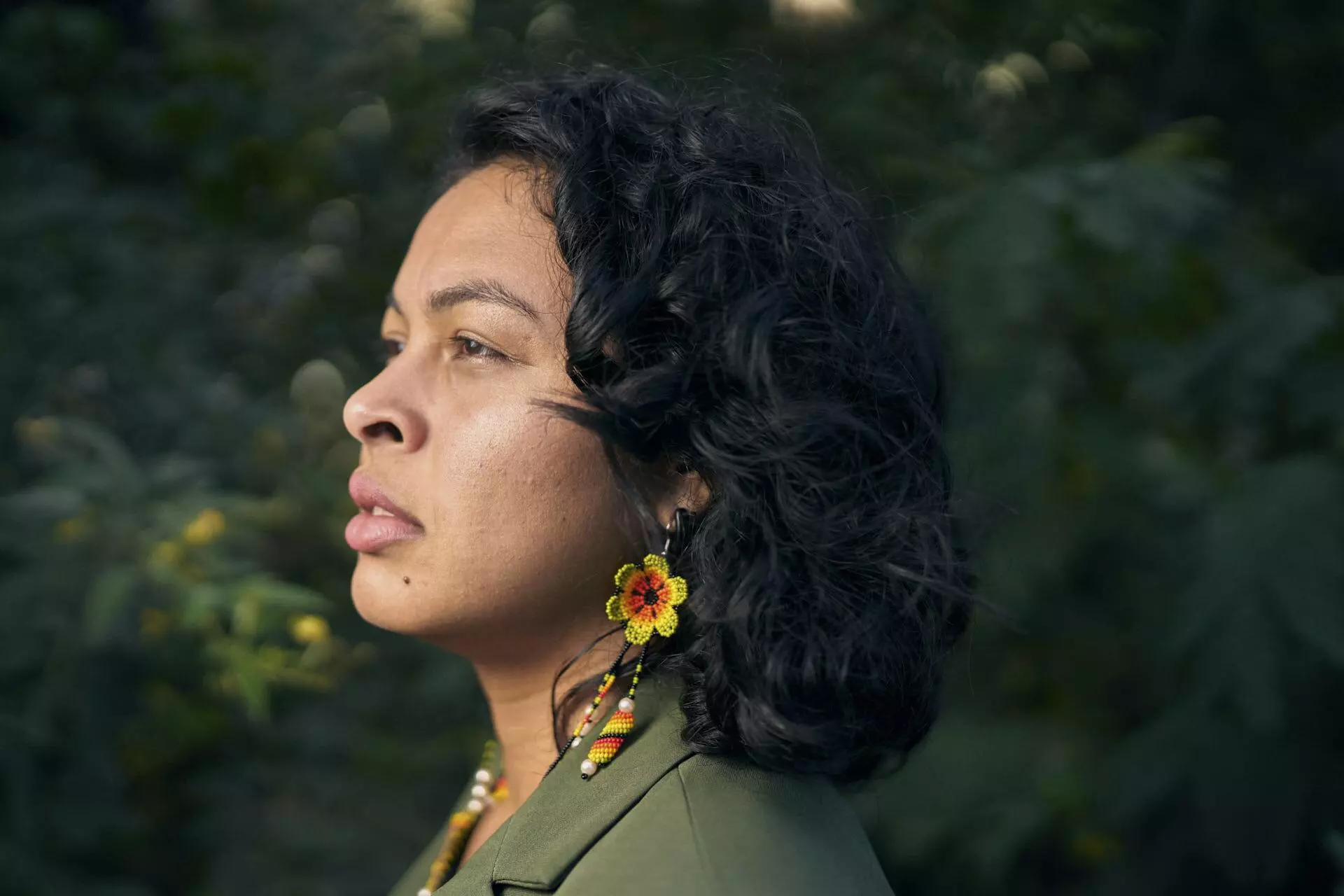
“I want people to see us,” Larissa says about Indigenous LGBTQIAPN+ youth. Photo: Pablo Albarenga/SUMAÚMA




